From a crumbling Victorian ground to an £800 million waterfront masterpiece that nearly bankrupted the club.
Everton’s journey to their new Hill Dickinson Stadium is the most dramatic stadium story in modern football – and it’s finally complete.
Let’s explore how they pulled off the impossible, what it really cost, and why this could change everything for the Toffees.
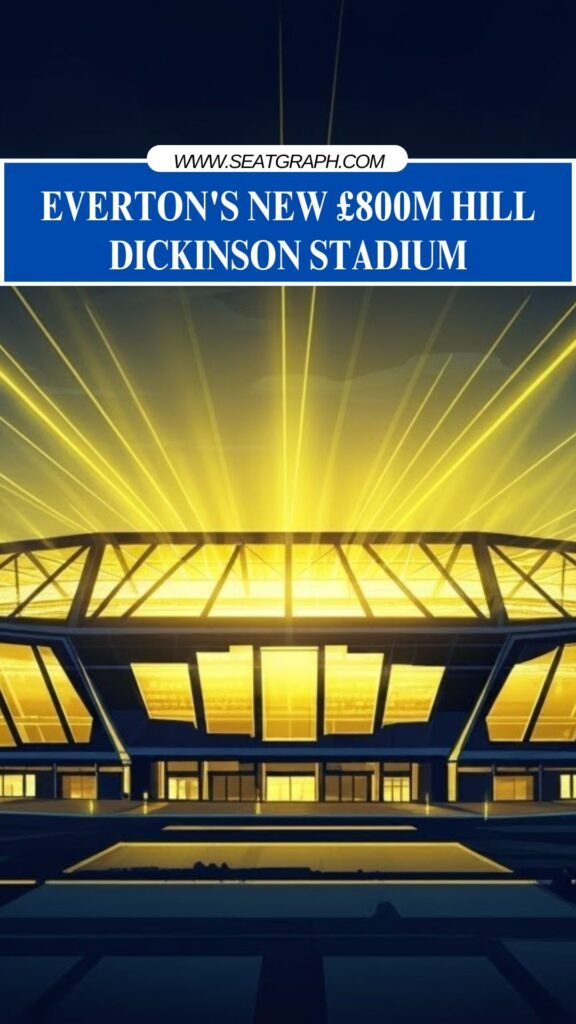
Everton’s New £800M Hill Dickinson Stadium Video
THE GOODISON PARK PROBLEM
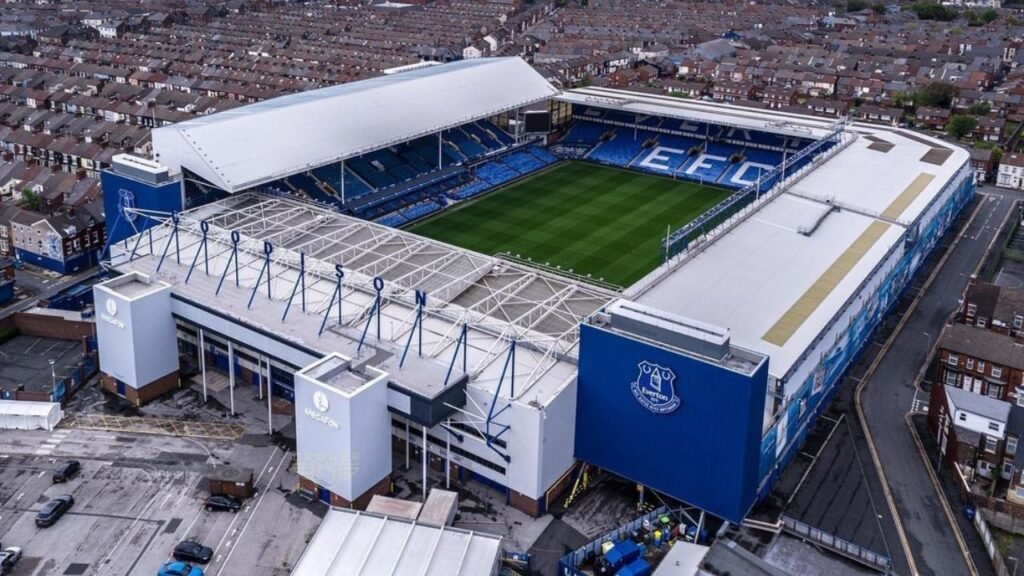
To understand why Everton spent £800 million on a new stadium, we need to look at what they were leaving behind.
Goodison Park, where Everton first played in 1892, had been gradually updated since its construction with the most recent major development being a new stand in August 1994, giving it an all-seater capacity of just over 39,000 – making it one of the smallest grounds in the Premier League.
But capacity wasn’t the only issue.
Goodison Park’s Victorian infrastructure was crumbling. The stadium had restricted views, narrow concourses, and limited commercial facilities.
While Liverpool were expanding Anfield, Everton were stuck with a ground that couldn’t generate the revenue needed to compete in modern football.
The numbers were stark: Goodison’s 39,000 capacity was dwarfed by rivals. Liverpool’s expanded Anfield holds 61,000, while Manchester United’s Old Trafford accommodates 74,000.
This capacity gap translated directly into a revenue disadvantage that was costing Everton millions every season.
The solution was radical: abandon their historic home and build from scratch on the banks of the River Mersey. This decision would define the next decade of Everton Football Club.
THE BRAMLEY-MOORE DOCK VISION
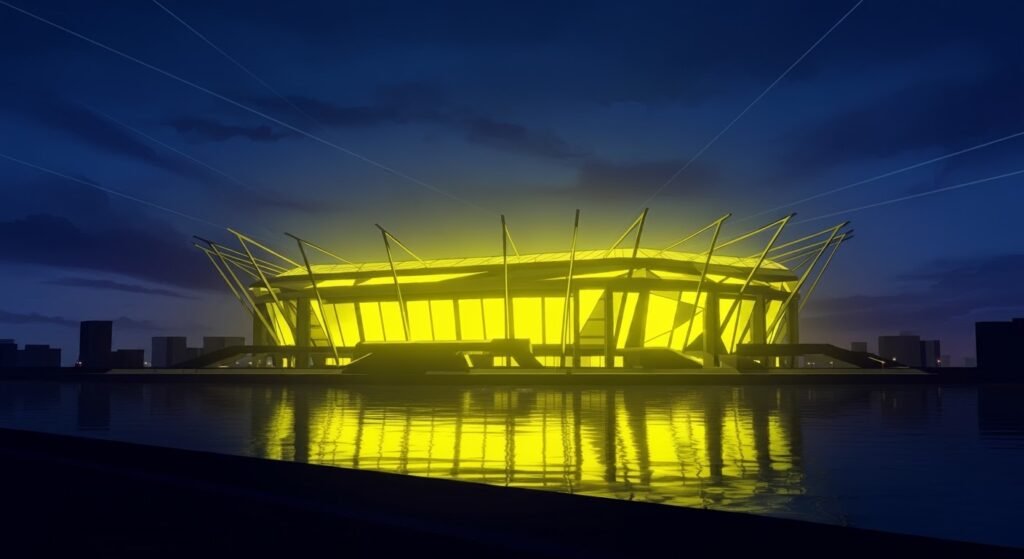
In 2017, Everton announced their audacious plan: to build a new stadium at Bramley-Moore Dock, a UNESCO World Heritage site on Liverpool’s waterfront. The location was breathtaking but came with unprecedented challenges.
The stadium is being built on a World Heritage site, so the design allows it to be dismantled and returned to a working dock if required in the future – a requirement that added millions to the construction costs but was necessary to gain planning permission.
The vision was ambitious: create a 52,888-capacity stadium that would become an iconic landmark on Liverpool’s skyline. The design featured a striking bowl shape with steep stands designed to create an intimidating atmosphere that could rival Goodison’s famous intensity.
But building on a former dock brought unique engineering challenges. The site required extensive foundational work, including driving concrete piles deep into the Mersey riverbed. The proximity to the water meant every aspect of construction had to account for tidal movements and potential flooding.
The location also promised to transform the entire area. Hill Dickinson Stadium, with a seating capacity of 52,888, is expected to attract more than 1.4 million visitors annually and provide thousands of jobs, serving as a beacon for restoration of the region around the docks.
THE FINANCIAL ROLLERCOASTER
What started as an ambitious project became a financial nightmare. Costs for the development of Everton’s new ground spiraled from an initial £500 million to more than £800 million, details disclosed in Premier League documents relating to the club’s appeal over last season’s 10-point deduction for breaching Profit and Sustainability Rules.
This wasn’t just inflation – it was a perfect storm of complications. The Heritage site requirements, complex engineering challenges, and supply chain disruptions during COVID-19 all contributed to the cost overruns.
By some estimates, the actual cost to build the stadium now would be more than £800 million, making it one of the most expensive stadium projects in football history.
The financial strain was enormous. Everton’s owner, Farhad Moshiri, had to secure additional funding multiple times. The club took out high-interest loans and even faced potential administration during the construction process.
The stadium project became a key factor in Everton’s financial fair play violations, contributing to their points deductions in recent seasons.
In March 2024, Alucraft Systems, a subcontractor supplying cladding panels for the stadium’s exterior, went into administration owing suppliers £7.7 million – highlighting how the financial pressures affected the entire supply chain.
The question many asked was: could Everton afford their dream stadium, or would it destroy the club?
CONSTRUCTION CHALLENGES AND DELAYS
Construction officially began in 2021, but the challenges were immediate and relentless. Building on a former dock meant dealing with contaminated soil, unpredictable ground conditions, and the constant threat of flooding from the River Mersey.
The engineering solution was innovative but expensive. Massive concrete piles were driven 40 meters into the ground to create stable foundations. The entire site had to be raised above potential flood levels, requiring millions of tons of fill material.
Construction of the £500M stadium on the banks of the River Mersey overcame its challenging location and made significant progress over the course of 2023, but delays were inevitable. The original opening date of August 2024 was pushed back multiple times.
Weather played havoc with the construction schedule. High winds off the Mersey regularly halted crane operations, while winter storms caused repeated delays. The complex facade work, featuring thousands of individual panels, required perfect conditions for installation.
The completed stadium was officially handed over by the contractor in December 2024, but fitting out and safety testing meant the stadium wouldn’t be ready for matches until the 2025-26 season.
THE STADIUM EXPERIENCE
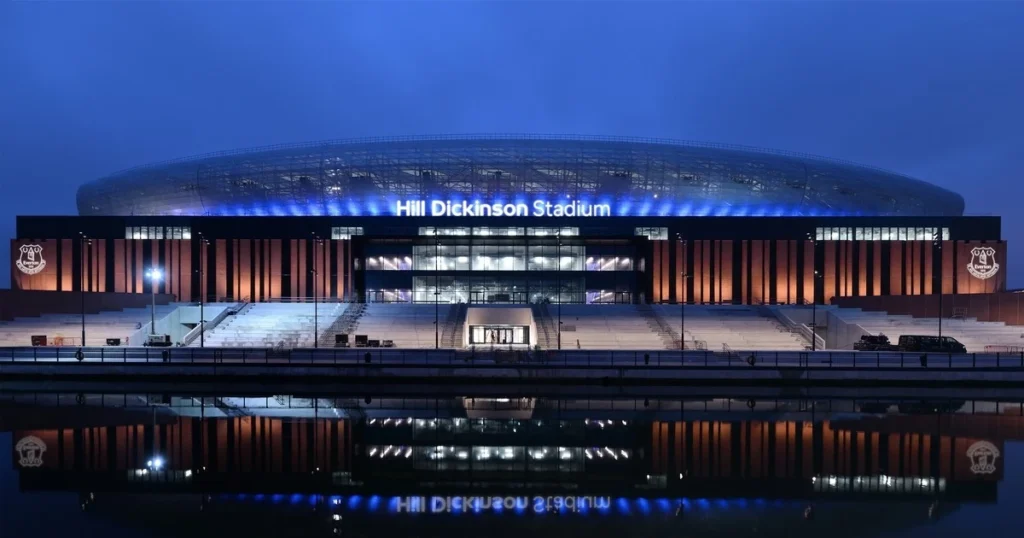
So what does £800 million buy you? The Hill Dickinson Stadium is a technological marvel that redefines the match-day experience. With a seating capacity of 52,888, it’s not just bigger than Goodison – it’s completely different.
The stadium features four distinct stands, each with its own character. The South Stand, designed for the most vocal supporters, rises at the steepest allowable angle to create a wall of noise. The premium West Stand houses corporate facilities and the stadium’s most expensive seats cost £50,000 per season for a pair.
All supporters pass through The Plaza – a vast outdoor space with capacity for up to 17,000 people, hosting pre- and post-match entertainment and activations. This creates a festival atmosphere that extends far beyond the 90 minutes of football.
THE ‘ALL’ EXPERIENCE AND HOSPITALITY REVOLUTION
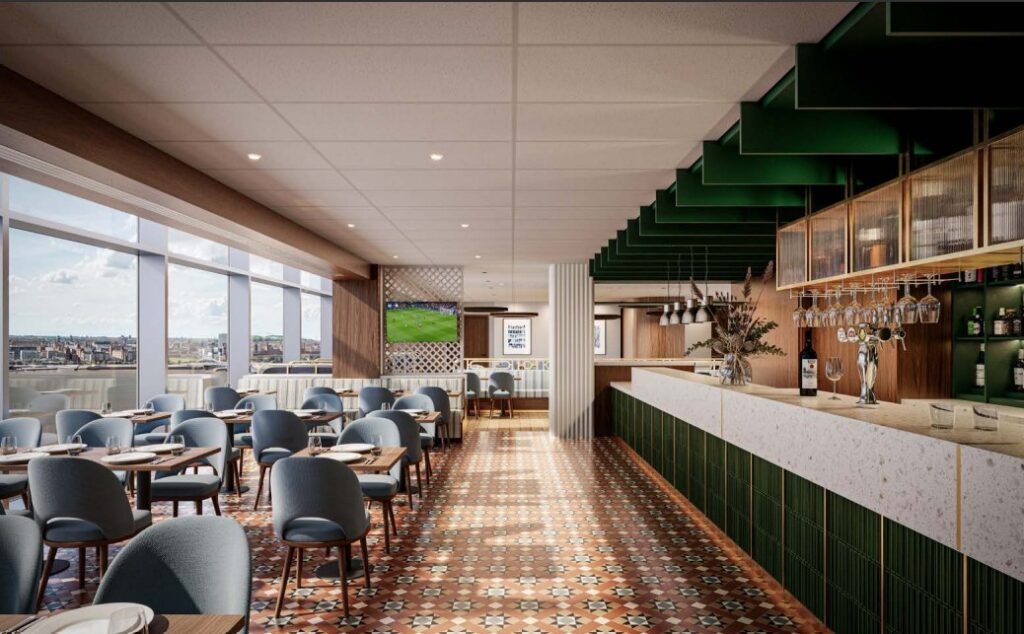
The real game-changer is what Everton calls the ‘ALL‘ experience – a complete reimagining of stadium hospitality. This isn’t just about upgrading the pies and pints; it’s about creating a destination venue that operates 365 days a year.
The hospitality offering spans multiple tiers, from high-street style restaurants to personal fine-dining experiences. Business customers can choose from river view and pitch view spaces, all equipped with robust AV systems, high-speed connectivity, and digital signage for seamless branding and personalization.
The Club View concourse represents a middle-tier hospitality option that’s revolutionary for football. Each membership includes a £10 credit for every matchday, exclusive entry into money-can’t-buy prize draws, and complimentary matchday programs. It’s designed to make premium experiences accessible to more supporters.
TECHNOLOGY AND CONNECTIVITY
This is where the £800 million investment really shows. Every seat has access to high-speed WiFi capable of handling 50,000+ simultaneous users – something that would have been impossible at Goodison Park. Mobile ordering systems mean no more missing crucial minutes queuing for refreshments.
The stadium’s digital infrastructure extends to dynamic pricing, personalized offers sent directly to fans’ phones, and integrated social media experiences. Digital signage throughout the concourses can be customized for different events, transforming the venue from football stadium to concert hall to corporate conference center.
FOOD, DRINK, AND RETAIL REVOLUTION
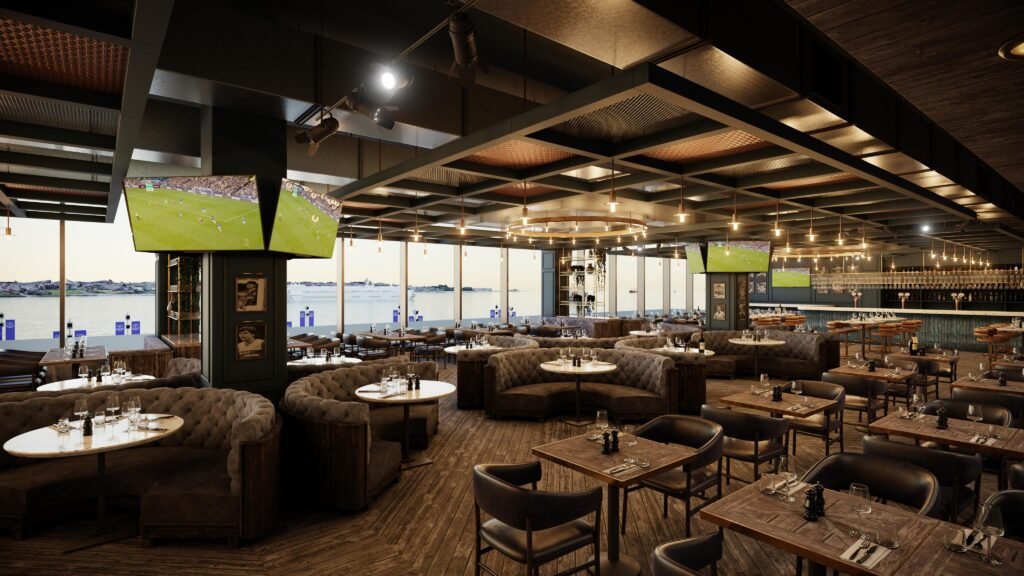
Gone are the basic burger and pie offerings of Goodison Park. The stadium features multiple themed bars and restaurants, each designed to cater to different demographics and price points. Village Street, the stadium’s main hospitality boulevard, houses everything from traditional pubs celebrating Everton’s history to upscale dining experiences.
The retail experience is equally transformed. Multiple club stores throughout the stadium mean merchandise is always accessible, while integrated payment systems allow cashless transactions throughout. Even the basic concession stands feature expanded menus with healthier options and locally sourced products.
ACCESSIBILITY AND SUSTAINABILITY
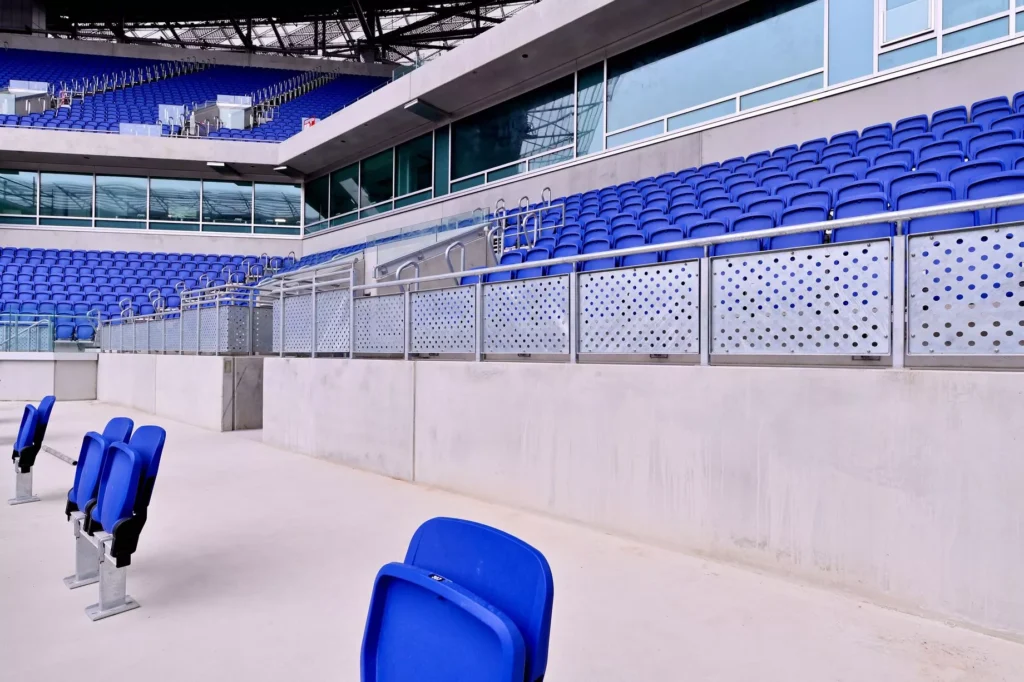
The stadium sets new standards for accessibility, with wheelchair accessible seating integrated throughout rather than segregated. Audio description services, hearing loops, and sensory rooms ensure the stadium is truly inclusive.
Sustainability features include rainwater harvesting systems, solar panels, and energy-efficient LED lighting throughout. The stadium is designed to achieve BREEAM ‘Excellent’ certification, making it one of the most environmentally friendly stadiums in world football.
Technology is embedded throughout. High-speed WiFi, mobile ordering systems, and digital ticketing create a seamless experience that transforms how supporters interact with the venue from arrival to departure.
THE NAMING RIGHTS DEAL: HILL DICKINSON STADIUM
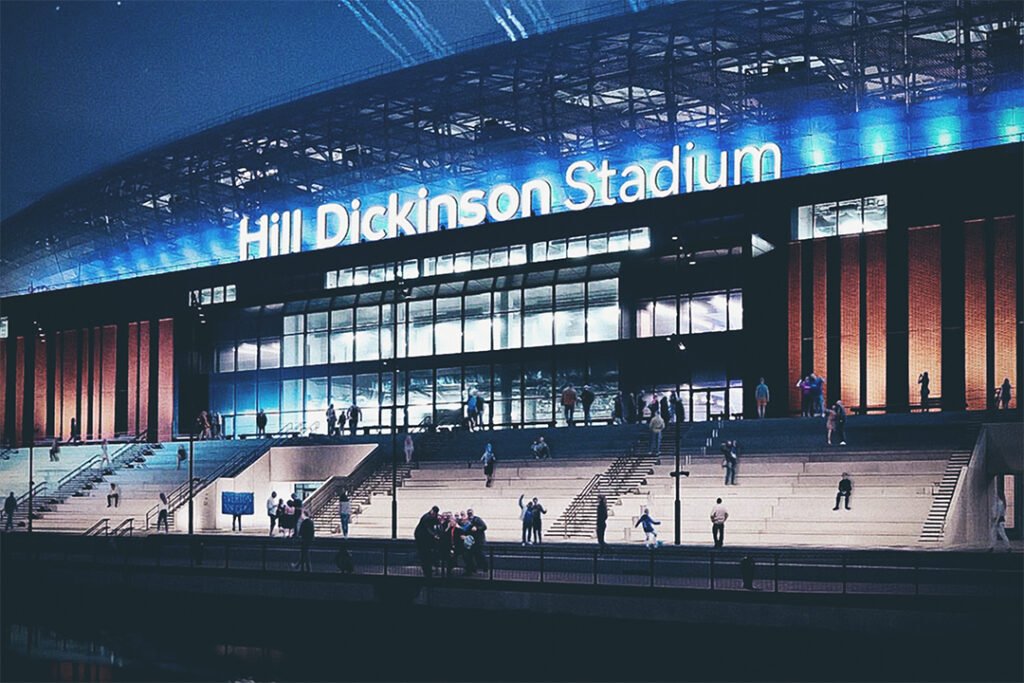
In an announcement, the Premier League club announced Hill Dickinson as the official naming rights partner for the club – a deal that provides crucial ongoing revenue for the debt-laden club.
While the financial terms weren’t disclosed, naming rights deals for stadiums of this caliber typically generate £5-10 million annually. For a club struggling with FFP compliance, this revenue stream is essential for long-term sustainability.
The partnership with Hill Dickinson, a Liverpool-based law firm, keeps the stadium’s identity local while providing the commercial backing Everton desperately needs. It’s a pragmatic solution that balances tradition with financial reality.
WHAT THIS MEANS FOR EVERTON’S FUTURE: THE TRANSFORMATION
The move to Hill Dickinson Stadium represents more than just a change of address – it’s Everton’s attempt to reset their entire trajectory. The increased capacity means an additional 13,000 seats per game, generating millions in extra match-day revenue.
But the real transformation is commercial. The new stadium’s hospitality facilities, corporate boxes, and event spaces will generate year-round income. The Hill Dickinson Stadium is set to undergo a capacity increase ahead of the 2028 Euros, potentially hosting major international matches and concerts.
For supporters, the atmosphere will be the ultimate test. Goodison Park was famous for its intimidating environment, with the crowd close to the pitch and noise levels that could rattle visiting teams. The new stadium’s bowl design and steep stands are specifically engineered to recreate and amplify this atmosphere.
The location also matters. Positioned on Liverpool’s iconic waterfront, the stadium becomes a destination in itself. The regeneration of the surrounding dock area will create a match-day experience that extends far beyond the stadium itself.
THE RISKS AND REALITY CHECK: CAN EVERTON AFFORD IT?
The brutal truth is that Everton nearly destroyed themselves building this stadium. The £800 million cost has left the club with massive debts and ongoing financial fair play challenges. The question isn’t just whether they can fill the seats – it’s whether they can service the debt.
The stadium needs to generate significantly more revenue just to break even on the investment. Season ticket prices have increased, corporate packages are expensive, and every event space needs to be maximized. There’s little room for error.
Recent takeover talks have centered on the stadium debt. Any new owner inherits both the asset and the financial burden. The stadium is magnificent, but it comes with a price tag that could define Everton’s future for decades.
CONCLUSION AND LEGACY
Everton’s journey to Hill Dickinson Stadium is the story of ambition colliding with financial reality. They’ve created something spectacular – a stadium that rivals any in world football and could transform their long-term prospects.
But it’s also a cautionary tale about the true cost of modern football infrastructure. The £800 million price tag exceeds the total value of most Premier League clubs. It’s a bet-the-farm gamble that could either secure Everton’s future or burden them for generations.
When the first match kicks off at Hill Dickinson Stadium, it will mark the end of one era and the beginning of another. Whether it’s remembered as the project that saved Everton or nearly destroyed them remains to be seen.
What’s certain is that this is more than a stadium – it’s Everton’s £800 million statement of intent. The question is: was it worth the risk?
What do you think of Everton’s new stadium gamble? Will the Hill Dickinson Stadium be worth the massive investment, or have the Toffees bitten off more than they can chew?
Let me know in the comments below, and if you enjoyed this deep dive into one of football’s most expensive stadium projects.

